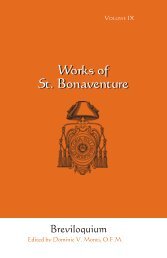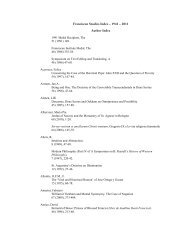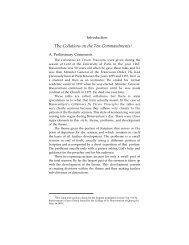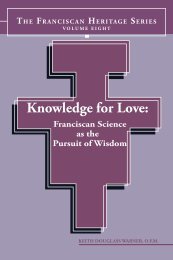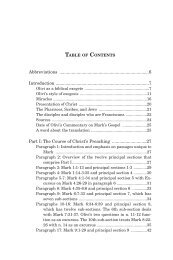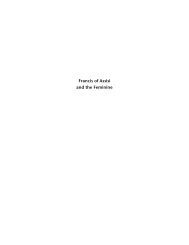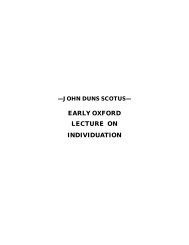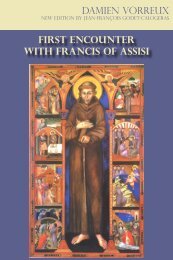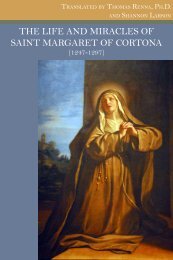FOUR QUESTIONS ON MARY - Franciscan Institute Publications
FOUR QUESTIONS ON MARY - Franciscan Institute Publications
FOUR QUESTIONS ON MARY - Franciscan Institute Publications
You also want an ePaper? Increase the reach of your titles
YUMPU automatically turns print PDFs into web optimized ePapers that Google loves.
John Duns Scotus: Four Questions on Mary<br />
gave a sound theological argument for celebrating Mary’s<br />
conception itself. If Jeremiah and the Baptist were sanctified<br />
before birth, how much more should Mary as the Queen of<br />
Angels and the tabernacle of the Son of God be completely<br />
untouched by sin. 9<br />
Eadmer’s interpretation, however, overcame one theological<br />
difficulty at the expense of creating a far more serious one<br />
based on a carefully worked out theory about the nature of<br />
original sin and its transmission to Adam’s progeny by sexual<br />
intercourse. It claimed when the newly created soul was<br />
infused into a seminally conceived fetus it contracted original<br />
sin. 10 It was only because concupiscence played no part<br />
9 Si igitur Jeremias ... in vulva est sanctificatus, et Joannes ... Spiritus<br />
sanctus ex utero Matris repletus, quis dicere audeat, singulare totius saeculi<br />
propitiatorium, ac Filii Dei omnipotentis dulcissimum reclinatorium,<br />
mox in sua conceptionis exordio Spiritus sancti gratiae illustratione destitutum<br />
... Angelis aliis peccantibus, bonos a peccatis servavit, et feminam<br />
Matrem suam mox futuram, ab aliorum peccatis exortus servare non valuit?<br />
In aeternitate consilii fixum statuit, eam dominatricem et reginam fore<br />
Angelorum, et nunc inferiorem Angelis natam est consortium acceptam esse<br />
credemus omnium peccatorum? Tractatus de conceptione B. Mariae Virginis<br />
(PL 159, 305, 307). Though the idea that since Mary was sanctified<br />
in the womb, she may never have contracted original sin was expressed<br />
earlier (cf. e.g., pseudo-Ildephonse [Radbertus], De partu virginis, PL 96,<br />
211), the Benedictine monk, Eadmer of Canterbury (d. 1124), is generally<br />
regarded as the first explicitly to connect her sanctification with the instant<br />
of her conception and use it as the rationale for celebrating this as a<br />
feast. As he was the secretary, disciple and biographer of St. Anselm, it is<br />
not surprising that his treatise as late as the fourteenth century, however,<br />
was mistakenly attributed to the Archbishop and Primate of England himself.<br />
Migne printed the tract among the spurious works of Anselm (PL 159,<br />
301-318; for a critical edition see Eadmeri monachii Cantuariensis tractatus<br />
de conceptione S. Mariae, ed. H. Thurston and T. Slater (Fribourg im<br />
Breisgau, 1904); for a study of his works as a whole and of his relationship<br />
with St. Anselm, see R. W. Southern, Saint Anselm and His Biographer<br />
(Cambridge: University Press, 1963).<br />
10 Before the fall, concupiscence or the natural human desire for sense<br />
pleasure was kept within the bounds of reason (see the following note);<br />
after the fall, it became a drive that could be controlled only with difficulty<br />
(cf. Rom. 7, 21-25). Concupiscence, as the insubordination of the flesh towards<br />
reason, with the unavoidable propensity to all kinds of evil, largely<br />
due to the influence of St. Augustine, came to be essentially identified with<br />
original sin. Since sin was removed by baptism, while concupiscence was<br />
not, Augustine’s theory was frankly insufficient and created more difficulties<br />
than it solved. St. Anselm of Canterbury produced a more satisfactory<br />
4



